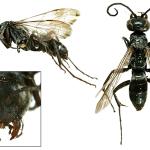A small black spider wasp. Males lack the ivory markings on the face and hind legs present in its congener Agenioideus cinctellus (Spinola), and females may be separated by the presence of a fore tarsal comb and by differences in dentition.
Until recently this species was thought to be confined to the Channel Islands within the British Isles. However, in 2005 it turned up in a garden in Midhurst, West Sussex, where it is apparently resident. Further examples were also taken at Folkestone, East Kent in 2006; University of East London, South Essex in 2009; Cliffe, West Kent in 2016; and Pegwell Bay, East Kent in 2017, so it would appear that the species is becoming established in south-east England.
Overseas it occurs in central and southern Europe (Wolf, 1972).
The Channel Islands are, for a number of reasons, excluded from the geographical coverage of the British Red Data book (Shirt, 1987) and the subsequent review (Falk, 1991). However, now it has been discovered in mainland Britain its status should be assessed.
Day, 1988 is the standard work for identifying British Pompilidae. Wiśniowski, B., 2009 is also useful.
Occurs in open sandy habitats, including gardens.
The few British records range from late May to August. Wiśniowski (2009) extends this to mid-October for Poland.
Probably a range of spiders. Day (1988) gives prey records from the families Salticidae, Pisauridae and Thomisidae.
Burrows are excavated in sand and loose stone walls, the tarsal comb being an adaptation for digging sand.
No data for Britain. In Poland it has been observed on unspecified Apiaceae (Wiśniowski, 2009), a plant family popular with the family as a whole.
2019


